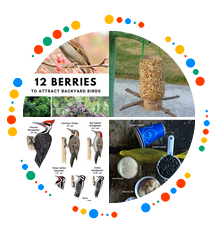It is time of year again to start planning for the Great Backyard Bird Count,  February 17-20, 2012.
February 17-20, 2012.
The Great Backyard Bird Count is easy and fun. Be sure to visit the website and read all the instructions, but in a nutshell you need to set aside at least 15 minutes on at least one of the days, gather a paper, pencil and a set of binoculars (optional) and count the birds you can see in your yard or neighborhood. When you are finished, you enter the data. Then check back to see what birds others have counted in your community.
Related activities:
1. Bird Watching
Bird watching is a popular and engaging activity. You don’t need to travel or have expensive gear to bird watch. You can simply look out the window and spot birds. Birds are interesting because they are colorful, active and can be found almost anywhere. At various times of year birds are migrating, singing, building nests and raising babies. There’s always something exciting going on among your neighborhood birds.
Are you a complete beginner? Learn your birds by figuring out a few at a time, using field guides and websites.
Keep a notebook full of drawings and notes next to your favorite birding window. Over the course of a year you will begin to recognize the regulars and also new birds.
Many communities offer bird hikes and birding classes. Check you local newspaper and do a few Internet searches for local birding clubs and events.
2. Bird Feeders
What can you do to encourage birds? Many people start by making simple bird feeders, such as the classic pine cone rolled in birdseed. Many of the crafts you see suggest using peanut butter, which is not fun at all for children with peanut allergies. Try this alternative that actually attracts a larger assortment of birds as well.
Gather:
- dry, clean pine cones, enough for all participants
- lard (available in most grocery stores) at room temperature
- bird seed
- ribbon or string
- plate or tray to spread seed on
- butter knife or craft sticks
Spread the bird seed on a tray. Tie the string or ribbon on the pine cones to serve as a hanger. Have the children “butter” the pine cones with lard, either using their fingers or craft sticks, filling in the cracks. Then roll the filled pine cones in the bird seed, which should stick. (Note: I found it was easier to tie the strings first, but you can also do it last). Hang the pine cones in a tree that you can watch and wait for the birds to discover it.
You can make another simple feeder by stringing fruit such as raisins, grapes, cherries or orange sections on a bit of twine or string and hanging it out. Just be careful and find out what works best in your region because scattering food for birds can also attract unwanted guests, including bears in some areas!
Often you can reduce the number of unwelcome guests by choosing what type of food you present and how. For example, niger thistle seed attracts colorful birds like finches and doves, but not pigeons or rats.
See our Pinterest board for more ideas.
Check with your local Audubon Society or other birding resources for even more recommendations (see links below).
3. Nesting Materials
Making cards full of nesting materials can be a fun project that is easy to do with supplies from around the house.
Gather:
- index cards or roughly three-inch by five-inch pieces of card stock, enough for all participants
- hole punch or scissors
- yarn, preferably wool or cotton
- thread
- hair or anything else you think a bird might use in its nest
- string or ribbon to hang card
Brainstorm about what might be useful to a bird. Poke holes in the index cards with a hole punch or cut holes with scissors (with an adult’s help). Tie a 12-inch piece of string, yarn or ribbon through one hole to serve as a hanger. Loosely stuff the rest of the holes with a variety of nest making supplies, making sure the birds can pull it out fairly easily. When you are finished, go outside and hang the cards in bushes or trees where the birds will find the materials. Check over time to see which materials they chose first, second, etc. Refill the cards as needed.
4. Bird Garden
If you get serious about birding, you might think about planting a bird garden. Find out abut which native plants in your area provide food or shelter for birds and add a few to your garden. Providing water through a birdbath or pond is also helpful as long as the water is kept clean and fresh. Check for more information in books, magazines and on the Internet for useful plants to grow in your region or community.
5. Fly like a Bird
Study birds in flight. Make a kite, decorate it like a bird and fly it on a windy day.
Finally, even if it is raining and nothing is happening outdoors, ask your child what it would be like to fly like a bird. Then pretend you are birds. Spread your wings and soar and swoop together.
For more information try:
Cornell Laboratory of Ornithology
For the Birds: The Life of Roger Tory Peterson by Peggy Thomas and illustrated by Laura Jacques
For more books about birds for children, check out our growing list at Science Books for Kids.
Disclosures: I am an affiliate for Amazon. If you click through the linked titles or ads and make a purchase, I will receive a small commission at no extra charge to you. Proceeds will be used to maintain this self-hosted blog.










































